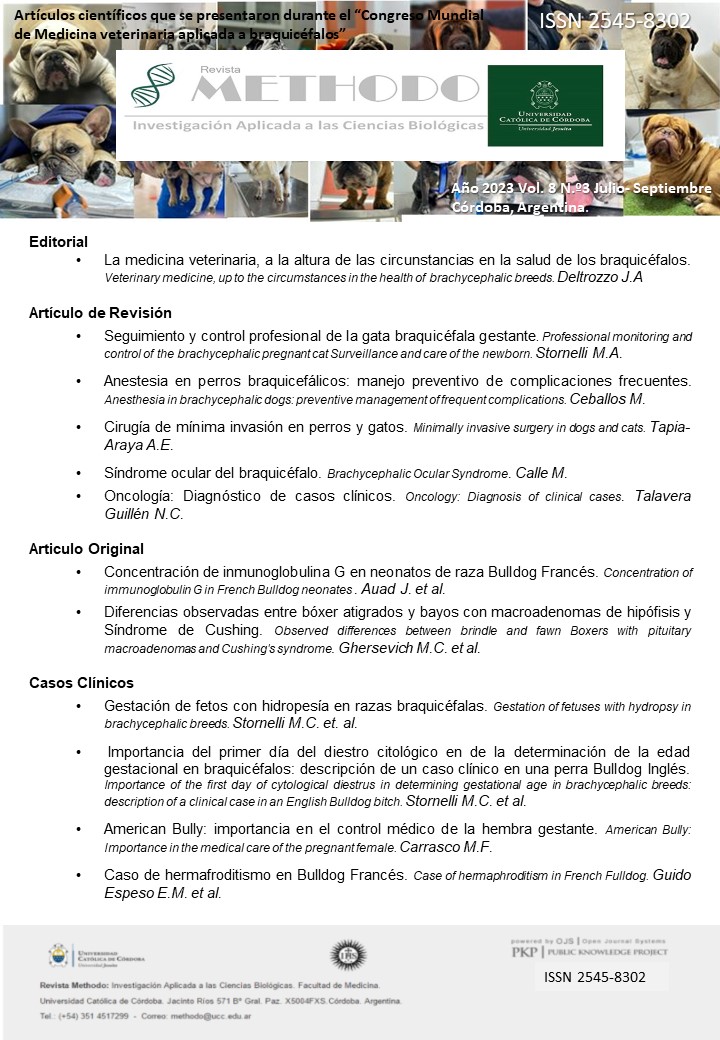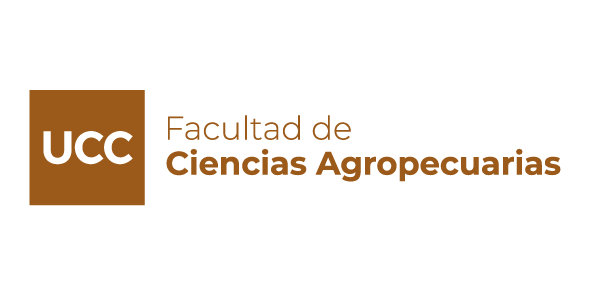Anestesia en perros braquicefálicos: manejo preventivo de complicaciones frecuentes
DOI:
https://doi.org/10.22529/me.2023.8(3)03Resumen
La mortalidad perianestésica en perros braquicefálicos es mayor fundamentalmente a las particularidades respiratorias y digestivas que presentan. Una adecuada estadificación de los mismos, para determinar elriesgo anestésico es fundamental a fin de establecer la estrategia anestésica adecuada. La preparación del paciente debe estar focalizada en disminuir la incidencia de vómito y regurgitación. El manejo de la vía aérea debe ser planificado, ya que la posibilidad de presentar una vía aérea dificultosa y compleja es factible. La mayor tasa de complicaciones ocurre en la recuperación donde la extubación debe ser realizada en forma tardía. Considerar tener todo preparado para re-anestesiar y re-intubar ante signos de obstrucción de la vía aérea. La oxigenoterapia humificada en el postoperatorio es fundamental, así como la posibilidad de requerir de nebulizaciones con vasoactivos, para disminuir la inflamación de la mucosa. El edema pulmonar no cardiogénico puede ser una causa de insuficiencia respiratoria aún unas horas después de la extubación.Descargas
Referencias
Oda, A., Wang, W. H., Hampton, A. K., Robertson, J. B., & Posner, L. P. (2022). Perianesthetic mortality in English Bulldogs: a retrospective analysis in 2010-2017. BMC Veterinary Research, 18(1), 1-9. https://doi.org/10.1186/s12917-022-03301-9
Lindsay, B., Cook, D., Wetzel, J. M., Siess, S., & Moses, P. (2020). Brachycephalic airway syndrome: management of post‐operative respiratory complications in 248 dogs. Australian veterinary journal, 98(5), 173-180. https://doi.org/10.1111/avj.12926
Poncet, C. M., Dupre, G. P., Freiche, V. G., Estrada, M. M., Poubanne, Y. A., & Bouvy, B. M. (2005). Prevalence of gastrointestinal tract lesions in 73 brachycephalic dogs with upper respiratory syndrome. Journal of small animal practice, 46(6), 273-279. https://doi.org/10.1111/j.1748-5827.2005.tb00320.x
Park, Y. W., Son, W. G., Jeong, M. B., Seo, K., Lee, L. Y., & Lee, I. (2013). Evaluation of risk factors for development of corneal ulcer after nonocular surgery in dogs: 14 cases (2009-2011). Journal of the American Veterinary Medical Association, 242(11), 1544-1548. https://doi.org/10.2460/javma.242.11.1544
Hoareau, G. L., Jourdan, G., Mellema, M., & Verwaerde, P. (2012). Evaluation of arterial blood gases and arterial blood pressures in brachycephalic dogs. Journal of Veterinary Internal Medicine, 26(4), 897-904. https://doi.org/10.1111/j.1939-1676.2012.00941.x
Doxey, S., & Boswood, A. (2004). Differences between breeds of dog in a measure of heart rate variability. Veterinary Record, 154(23), 713-717. https://doi.org/10.1136/vr.154.23.713
de Melo Dias, M. L., Morris, C. F. M., Moreti, B. M., do Espírito Santo, A. V., McManus, C. M., de Almeida, R. M., & Galera, P. D. (2016). Anatomical, cardiovascular, and blood gas parameters in dogs with brachycephalic syndrome. Acta Scientiae Veterinariae, 44, 1-6. https://doi.org/10.22456/1679-9216.80932
Davis, M. S., Cummings, S. L., & Payton, M. E. (2017). Effect of brachycephaly and body condition score on respiratory thermoregulation of healthy dogs. Journal of the American Veterinary Medical Association, 251(10), 1160-1165. https://doi.org/10.2460/javma.251.10.1160
Downing, F.; Gibson, S. (2018). Anaesthesia of brachycephalic dogs. Journal of Small Animal Practice, 59 (12): 725-733. https://doi.org/10.1111/jsap.12948
Leonardi, F.; Simonazzi, B.; Martini, F.; Zanichelli, S.; Sansone, T. Botti, P. (2007). Clinical comparison of medetomidine-butorphanol, medetomidine-midazolam and midazolam-butorphanol for intramuscular premedication in the english bulldog.Ann. Fac. Medic. Vet. di Parma (Vol. XXVII, 2007) pag. 131 - pag. 142
Nejamkin, P., Araos, J., Genaro, A., & Martin-Flores, M. (2021). Pilot evaluation of a three dimensionalprinted oropharyngeal airway device for brachycephalic dogs. Veterinary Anaesthesia and Analgesia, 48(3), 478- 479. https://doi.org/10.1016/j.vaa.2021.03.001
Gruenheid, M., Aarnes, T. K., McLoughlin, M. A., Simpson, E. M., Mathys, D. A., Mollenkopf, D. F., & Wittum, T. E. (2018). Risk of anesthesia-related complications in brachycephalic dogs. Journal of the American Veterinary Medical Association, 253(3), 301-306. https://doi.org/10.2460/javma.253.3.301
Robinson, E., Sanderson, S., Natalini, C., & Osborne, C. (2000). Comparison of propofol and etomidate for anesthetic induction in bulldogs. Veterinary Anaesthesia and Analgesia, 27(2), 100- 101. https://doi.org/10.1016/S1467-2987(16)31344-7
Ellis, J., & Leece, E. A. (2017). Nebulized adrenaline in the postoperative management of brachycephalic obstructive airway syndrome in a pug. Journal of the American Animal Hospital Association, 53(2), 107-110. https://doi.org/10.5326/JAAHA-MS-6466
Franklin, P. H., Liu, N. C., & Ladlow, J. F. (2021). Nebulization of epinephrine to reduce the severity of brachycephalic obstructive airway syndrome in dogs. Veterinary Surgery, 50(1), 62-70. https://doi.org/10.1111/vsu.13523
Staffieri, F.; Crovace, A.; De Monte, V.; Centonze, P.; Gigante, G.; Grasso, S. (2014). Noninvasive continuous positive airway pressure delivered using a pediatric helmet in dogs recovering from general anesthesia. Journal of veterinary emergency and critical care, 24 (5): 578-585 https://doi.org/10.1111/vec.12210
Rondelli, V., Guarracino, A., Iacobellis, P., Grasso, S., Stripoli, T., Lacitignola, L., ... & Staffieri, F. (2020). Evaluation of the effects of helmet continuous positive airway pressure on laryngeal size in dogs anesthetized with propofol and fentanyl using computed tomography. Journal of Veterinary Emergency and Critical Care, 30(5), 543-549. https://doi.org/10.1111/vec.12977
Rondelli, V., Briganti, A., Centonze, P., Perini, F., Romano, F., Bufalari, A., ... & Staffieri, F. (2016). Respiratory effects of continuous positive airway pressure administered during recovery from general anaesthesia in brachycephalic dogs. Vet Anaesth Analg, 43, A15.
Darcy, H. P., Humm, K., & Ter Haar, G. (2018). Retrospective analysis of incidence, clinical features, potential risk factors, and prognostic indicators for aspiration pneumonia in three brachycephalic dog breeds. Journal of the American Veterinary Medical Association, 253(7), 869-876. https://doi.org/10.2460/javma.253.7.869












